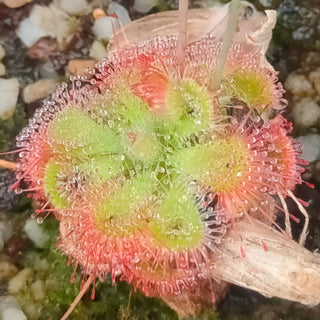Stylophorum diphyllum
CELANDINE POPPY, WOOD POPPY
- Unit price
- / per
Stylophorum diphyllum, commonly called the celandine-poppy or woods-poppy, is an herbaceous plant in the poppy family (Papaveraceae). It is native to North America, where it is found in the eastern United States and Ontario. Its typical natural habitat is moist forests over calcareous rock, particularly in ras.
It is cultivated for its bright yellow flowers. The common name is derived from greater celandine (Chelidonium majus), a closely related European plant with similar flowers and leaves.
In spring, the deep yellow flowers of the celandine poppy appear as a brilliant display on the forest floor. The flowers have 4 yellow petals, two soon-falling sepals, many yellow-orange stamens, and a single knobby stigma. They appear singly or in umbels of two to four flowers from early spring to early summer. Plants grow to about 1.5 feet (0.46 m) tall, from underground rhizomes. Leaves are pinnately cut and lobed.
Plants are relatively long lived and readily self-seed under garden conditions.
Stylophorum diphyllum is a conservative species, and is somewhat uncommon throughout its range. Forest clearance is responsible for some of the loss.
Due to its limited distribution in Canada, it is listed under Ontario's Endangered Species Act, 2007, which protects the species and its habitat. One Ontario population of the wood poppy is in a conservation area.
Type: Hardy perennial
Hardiness zones: 4-8
Height: 12", 30 cm
Location: Full shade to part shade
Seeds per packet: 10
Sow just under the surface of the soil and water in. Leave them at room temperature for 6 weeks. This helps break the phytohormones which inhibit germination. They will not grow yet. Then a cooling period is required. Cover them with plastic and place in a fridge for 80 days. Be sure they stay moist. After the cold stratification period they are then brought back to a cool room (15-18C, 59-68F) for them to germinate. Germination can be erratic, generally 30-90 days after the warming period for most seeds, though some can take longer.
Ornamental use only. These seeds and or plants are poisonous.
Stylophorum diphyllum
CELANDINE POPPY, WOOD POPPY
- Unit price
- / per
Multiple secure payment options available.
Adding product to your cart
You may also like
Stylophorum diphyllum, commonly called the celandine-poppy or woods-poppy, is an herbaceous plant in the poppy family (Papaveraceae). It is native to North America, where it is found in the eastern United States and Ontario. Its typical natural habitat is moist forests over calcareous rock, particularly in ras.
It is cultivated for its bright yellow flowers. The common name is derived from greater celandine (Chelidonium majus), a closely related European plant with similar flowers and leaves.
In spring, the deep yellow flowers of the celandine poppy appear as a brilliant display on the forest floor. The flowers have 4 yellow petals, two soon-falling sepals, many yellow-orange stamens, and a single knobby stigma. They appear singly or in umbels of two to four flowers from early spring to early summer. Plants grow to about 1.5 feet (0.46 m) tall, from underground rhizomes. Leaves are pinnately cut and lobed.
Plants are relatively long lived and readily self-seed under garden conditions.
Stylophorum diphyllum is a conservative species, and is somewhat uncommon throughout its range. Forest clearance is responsible for some of the loss.
Due to its limited distribution in Canada, it is listed under Ontario's Endangered Species Act, 2007, which protects the species and its habitat. One Ontario population of the wood poppy is in a conservation area.
Type: Hardy perennial
Hardiness zones: 4-8
Height: 12", 30 cm
Location: Full shade to part shade
Seeds per packet: 10
Sow just under the surface of the soil and water in. Leave them at room temperature for 6 weeks. This helps break the phytohormones which inhibit germination. They will not grow yet. Then a cooling period is required. Cover them with plastic and place in a fridge for 80 days. Be sure they stay moist. After the cold stratification period they are then brought back to a cool room (15-18C, 59-68F) for them to germinate. Germination can be erratic, generally 30-90 days after the warming period for most seeds, though some can take longer.
Ornamental use only. These seeds and or plants are poisonous.
















































